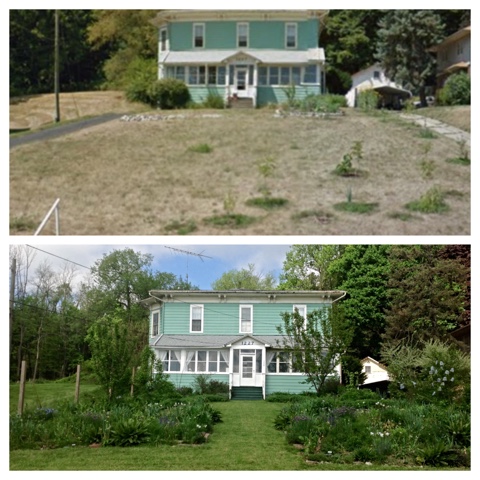There's nothing more powerful than beginning. In a few short years, you'll look back and be amazed by what you've accomplished.
The picture above shows our first steps at Lillie House. We began with 3 strategies at once.
First, we created our first "zone 1" garden area, a guild right outside our front door, with a few favorite annual vegetables, and a collection of important perennials, including our favorite Egyptian walking onions. We planned out this guild in detail, prepared the site, contoured the beds to collect water, dug a trench to collect water from our down spouts, planted and mulched. Since then, this part of our yard has required almost no additional maintenance, while it has provided much of the plant material we've used to transform the rest of our property.
At the same time, we planted out most of the woody perennials for our hedgerow. Slowly we added perennial vegetables to the hedgerow as we had time and plants to do so. We guilded each tree with garlic, walking onions, and a few other spreading perennials, to help reduce the work. We would "spot mulch" parts of the hedgerow as necessary, with woodchips or whatever else we had on hand. Jerusalem artichokes filled in the spaces between the plants in the second year, and since then, it has continued to grow and mature with just small inputs and additions.
In our backyard, we planted out our major "over-story" trees in the first Spring. If necessary, we could have waited, but it's always good to get trees in early if possible. We transplated some blackberries and black raspberries and let them go to town! They have provided a major yield in the early years, and they've died back as the system has filled in, which is what they generally do in nature, as "pioneer species."
In our backyard, we planned out our main permanent paths and we stopped mowing everything else. The second you stop mowing and spraying lawn, nature gets right to work enriching your soil and your yard, and you have more time to help her out. We've slowly added to each little guild, replacing "weeds" that had done their hard work on the soil for us, with species that were of more value to humans and wildlife. Thistles became cardoon. Dock became various garden sorrels.
"No till" potatoes became a common transitional plant, as it's easy as pie to "chop and drop" a bit of unmown grass and "weeds," plop an extra potato down on top of them and add some compost and more mulch on top of that. Many of these patches have perennialized, giving us potatoes for many years, while creating fantastic garden soil. I can create a new potato patch in about a minute, that will give potatos for years.
And at each step, it has been as important to ask, as "Natural Farming" author Masanobu Fukuoka did, "what can I NOT do?" as it has been to "get stuff done."
If you over-do the "inputs" as you create your garden, you tend to create systems that require continued intervention and work. But if you let nature do as much prep work as possible, you tend to end up with systems that take good care of themselves.
Working in that way, with nature, things will transform much more quickly than you'd believe.
All it takes is to get started.



No comments:
Post a Comment